
|
Special Effects (F/X) - Milestones in Film 2008-2009 |
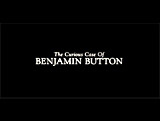
|
The Curious Case of Benjamin Button (2008)
A computer-generated copy of Pitt's aged face was grafted by special effects experts onto various smaller bodies during Benjamin's growing-up (or growing-down) years, especially during the first third of the film. The breakthrough special effects were elaborate and seamlessly integrated, using a new facial performance capturing system called "Contour" to track an actor's facial movement in three-dimensional space. The studio, Digital Domain, admitted: "There's 325 shots - 52 minutes of the film - where there is no actual footage of Brad."
In his early years, at age 5 approximately, he appeared to be a short, frail, bald elderly man with glasses. He graduated from a wheel chair to a cane, and then in puberty grew hair, gained muscle tone, and looked healthier. At around age 17, he took a job on a tugboat, through the bombing of Pearl Harbor in 1941 and the war years. After the war, Benjamin appeared to be 50 years old, although he was only 26 chronologically. [Also, prosthetic make-up allowed Cate Blanchett to morph into a withered, dying old woman.] In 1962, after the healing of lover/girlfriend Daisy (Cate Blanchett) following a car accident, Benjamin appeared to be in his late 30s or early 40s, and both of them were in the prime of their lives. When he was 49 years old in 1967, she was 43 years old ("We are almost the same age"). Things went on the decline after that --- after their baby born out of wedlock in 1968, who was named Caroline, had her first birthday, Benjamin decided that the baby deserved a father and not a playmate, and left everything to Daisy before leaving to wander the world. By film's end, Benjamin as a minor 12 year old (with acne) (portrayed by a younger actor) was found living in a condemned building in New Orleans. Daisy cared for Benjamin, who didn't recognize her but felt like he should know her, since he was suffering from the effects of dementia and Alzheimer's disease. Eventually, he became an infant in Daisy's arms, where he died. On her deathbed, the film's twist was revealed and seen in flashback. Daisy revealed that her 40-ish daughter Caroline (Julia Ormond) was Daisy's daughter by Benjamin, born out of wedlock. |
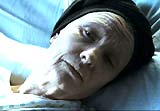 Daisy (Cate Blanchett) 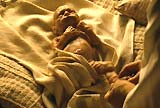 1918 - Birth 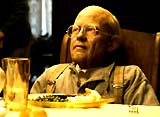 approx 5 years old 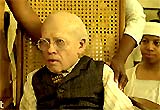 in the 1930s 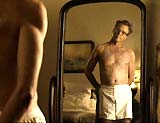
1945 - 26 yrs old 
As a young man, approx. 40 years in the 1960s 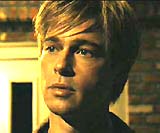 as a 20 year old 
as 12 year old |
||||||||||||

|
Doctor Who (2005- ) - TV Show "Partners in Crime" (Season 4, Episode 1) This BBC science-fiction TV show was the first to use the Massive AI system software, normally used for crowd sequences or for battle sequences in science-fiction and fantasy films (i.e., The Lord of the Rings). Now in its 4th season (or series) during 2008, in the first of its 13 episodes, "Partners in Crime," (airing in late April of 2008), an investigation was underway regarding weight-loss pills tested by Adipose Industries, and led by Miss Foster (Sarah Lancashire) (revealed by the end as an alien nanny). Both Donna Noble (Catherine Tate) and the Doctor (David Tennant) were involved in the case. The revolutionary diet pills, taken at night, caused excess fat to literally melt away in the form of tiny marshmallowy creatures, as seen in CGI sequences. People taking the weight-loss pill dissolved or vanished (and died in the process) into dozens of fat blobs as the advertisement claimed: "the fat just walks away." The alien creatures, called Adipose, were short white, humanoid blobs of fat that then terrorized London. In the show's conclusion, a nursery mothership arrived and collected the adipose babies by beaming them up. |
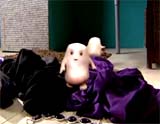  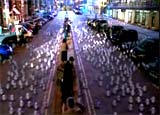 Adipose Creatures  Beaming Up the Adipose Into the Mothership |
||||||||||||

|
WALL-E (2008) Pixar's and Disney's animated science-fiction love story and comedy (their 9th film), filmed like a live-action film, was set in the year 2805. It told about the title character - the last lone garbage-compacting robot on Earth named WALL·E (short for Waste Allocation Load Lifter Earth-class) (voice of Ben Burtt). The ecological robot (similar to the robot in Short Circuit (1986) and to Spielberg's E.T.: The Extra-Terrestrial (1982)) was composed of a pair of binoculars (for eyes), with a turtle-like body and tank treads for locomotion. His modern female robotic counterpart was EVE (short for Extra-terrestrial Vegetation Evaluator) (voice of Elissa Knight), a sleek, white-shelled probe droid-robot that was sent to check on the progress of the clean-up and to locate plant life. In a clever reversal for a Pixar feature-length film, and a milestone first, it was the first Pixar animated feature with short segments featuring recorded live-action characters including:
Society had been reduced to Bob's Big-Boy styled, fat and lazy fatsos, who were reclining on floating, robotic lounge chairs on the 700th year anniversary of their 5-year cruise, on the starliner AXIOM. The starship was on robotic AUTO-pilot (a rogue AI, modeled after 2001's HAL computer), although it was reportedly being supervised by the ship's corpulent Captain McCrea (voice of Jeff Garlin). |
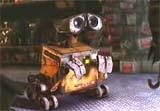 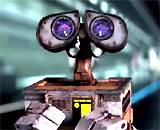 WALL-E 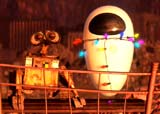 EVE 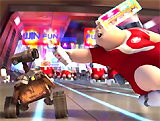 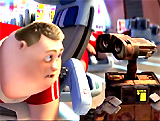 Fatsos |
||||||||||||

|
Waltz with Bashir (2008, Isr.) (aka Vals Im Bashir) Waltz with Bashir (2008, Isr.) was the first animated film to be nominated in the Best Foreign Film Oscar category. Functioning partially as an oral-history documentary, the introspective, dream-like anti-war polemic was a confessional account of director Ari Folman's devastating and traumatic experience as a young Israeli soldier during his country's 1982 invasion of Lebanon, and its massacre of over 3,000 Palestinian refugees. Ari Folman's film was first shot as a documentary with three DV-CAMs, and then painstakingly transformed into animation. It took two years to animate, and was completed by a small team of artists (eight animators, four illustrators, one After- Effects artist and one editor), who combined hand-drawing with the latest technological tools. Their work resulted in thick-lined, near-monochromatic animated images - frequently seen in strange, monocromatic yellowish or orange light. The animators based their drawings on staged and videotaped interviews, although the end result looked similar in some ways to the rotoscope technique used in director Richard Linklater's film Waking Life (2001). In the conclusion, the film suddenly switched from animation to video footage, to reinforce the deadly reality of the massacre. |
   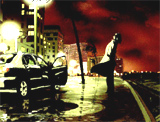 Monochromatic Animated Images 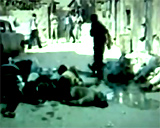 Video Footage of the Massacre in the Conclusion |
||||||||||||
Avatar (2009)
Much of the film's reported budget of over $300 million was spent on cutting-edge CGI and advanced motion-capture techniques. (40% of the film was live-action while 60% was photo-realistic CGI). Although originally scheduled for release in late spring of 2009, the opening was delayed until mid-December 2009, due to the demands of the special effects on computer renderings, and the installation of 3-D projection systems to accommodate the film worldwide. Over a period of years, Cameron designed dual-function cameras that simultaneously filmed in both conventional 2-D and state of the art 3-D. The film utilized motion performance-capture assisted CGI technology with actors on a stage (called the Volume), to create the sympathetic Na'vi characters. The technique of performance capture involved putting actors into bodysuits covered with tiny dots, while about 140 digital cameras captured their body movements. Also, a tiny helmet-rigged camera (on a skullcap) was used for recording finer facial, eye, and head movements. And then the digitally-recorded data was used by animators to create the characters in their virtual world environment.
Various striking elements in the film included:
|
The Earth-like Moon of Pandora Jake Viewing His Own Avatar For the First Time Jake as His Avatar - Disobedient to The Lab Team Jake Taught by Neytiri to Mount a Direhorse Named Pale and Establish a Bond with It |
|||||||||||||

|
A Christmas Carol (2009) Performance capture-advocate Robert Zemeckis had previously experimented with the technology in his own The Polar Express (2004) and Beowulf (2007), and again used the technique in this film. Disney's 3-D motion-captured A Christmas Carol (2009), an adaptation of Dickens' 1843 classic story, was released in both Disney Digital 3-D and in IMAX 3-D. It was the first Disney animated film released in this format. It was Zemeckis' first film with Disney since Who Framed Roger Rabbit (1988). In the film, Jim Carrey played multiple roles, including old Victorian-era miser Scrooge (at different stages of his life) and all three of the Christmas ghosts (spirits) that visited him:
Performance capture (or motion capture) digitally blended live performance and animated elements. Actors wore heavy, dot-sensor-covered spandex body suits and a helmet, and initially acted out their scenes in isolation from other sets, props, costumes, or actors. Expressions and movements were first recorded by digital cameras as 3D "moving data points" - and afterwards, the digitally-recorded performances were translated and embellished by key-frame artists and integrated into an exclusively virtual environment (Victorian London). |
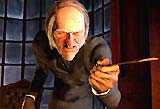  Scrooge (Jim Carrey)  Ghost of Jacob Marley (Gary Oldman) |
||||||||||||

|
Monsters vs. Aliens (2009) The DreamWorks sci-fi spoof and parody of 50s monster B-movies (its 18th feature), Monsters vs. Aliens, was based on the 1980s comic book Rex Havoc and the Ass-Kickers of the Fantastic. It was the first computer-animated feature film for the studio to be shot directly in stereoscopic 3-D -- dubbed the Ultimate 3-D. Previously, 3-D CGI films were made in a non 3-D version and then dimensionalized. DreamWorks claimed that it took approximately 45.6 million computing hours to make Monsters vs. Aliens, more than eight times as much as the original Shrek (2001). The 3-D effect was used mostly for the creation of amazing visual depth and texture, rather than for the stunts. [Note: Other 3-D computer-animated films would also debut in the new format: 20th Century Fox's and James Cameron's Avatar (2009), Fox's Ice Age 3 (2009), Disney's motion-capture A Christmas Carol (2009), and Pixar's Toy Story 3 (2010).] The tagline was: "ALIEN PROBLEM? MONSTER SOLUTION." It told about the deployment of a 350 foot tall Giant Robot Probe (with AI robots onboard), commanded by evil squid-like, tentacled alien king Gallaxhar (Rainn Wilson) with four eyes. The aliens were targeting Earth's supply of "quantonium." At the same time, the wedding of bride Susan Murphy (Reese Witherspoon) to egotistical local weatherman Derek Dietl (Paul Rudd) was disrupted when she was hit by a radioactive meteor and became almost 50 feet tall - and was thereafter renamed Ginormica. The military, led by General W.R. Monger (Kiefer Sutherland), convinced doltish President Hathaway (Stephen Colbert), who had failed miserably in his attempt to communicate with the alien robot by playing both the tune from "Close Encounters" and "Axel F" on a keyboard, to use Susan and other 'monsters' superheroes to vanquish the intergalactic destructive and invasive threat. The group of five 'monsters,' (each of which had similarities to characters in popular sci-fi/horror B movies from the 1950s) included:
The most spectacular set-piece in the film occurred on San Francisco's Golden Gate Bridge, and the best single image was of giant Susan roller-skating with a pair of convertibles on her feet. |
 The Giant Alien Probe 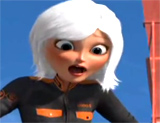 Ginormica 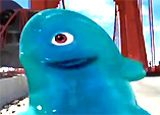 B.O.B. 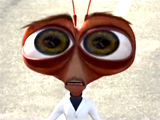 Dr. Cockroach 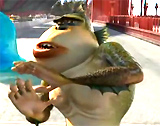 The Missing Link  Insecto 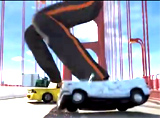 Rollerskating on Cars 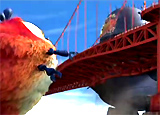 Golden Gate Bridge Showdown |
||||||||||||
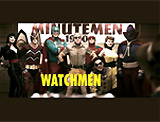
|
Watchmen (2009) This was a filmed adaptation of Alan Moore's graphic novel (a 12-issue publication by DC Comics between 1986 and 1987) by director Zack Snyder, about a superhero during a mid-1980s Cold War (in an alternate universe). There were about 1,100 shots with visual effects. The main character was mild-mannered nuclear physicist Jon Osterman (Billy Crudup), who then became the all-powerful, blue-glowing "atomized" scientist Dr. Manhattan, a demi-god who could manipulate time and space. After a freak accident when he was accidentally locked into a test chamber and was atomized, he died but then months later rematerialized as the immortal, matter-manipulating Dr. Manhattan (named after the atomic bomb project). The photo-realistic, all-CGI character of Dr. Manhattan was created with the process of motion capture. Dr. Manhattan's character appeared in approximately 38 minutes of the entire film. The body of fitness model and actor Greg Plitt was used as the 3-D digitized model for Dr. Manhattan's ultra-buff body. Crudup's 3-D digitized head was then grafted onto Plitt's body. Actor Crudup wore a specially-designed motion capture suit covered with pattern markers and face markers - he was filmed with two to four HD "witness" cameras (in addition to the film's master camera) to capture his overall full-body movements and facial expressions. All the cameras were synced so animators could then triangulate Crudup's performance in-frame. The number of black facial markers on the suit was a record 165 spot points, allowing the animators to track his expressions through video and then use that data as a jumping-off point to hand-animate Manhattan's face. Crudup's suit was also equipped with 2500 LEDs to create Manhattan's diffuse blue glow. |
 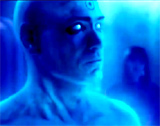 Dr. Manhattan (Billy Crudup)   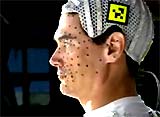 Motion Capture Technique |
||||||||||||